FFG. nos ofrece hoy, más información e imágenes (que siempre son mejores que múltiples explicaciones), del que será su primer DeckBuilder.
FFG entra con este juego ambientado en los mundos de Terrinoth, en la moda de los DeckBuilder que inició con mucho éxito Dominon.
Edge, todavía no se ha pronunciado sobre si piensa traer este juego a nuestro país traducido a la lengua de Cervantes.
De momento, para los que estéis interesados, al igual que un servidor, unas cuantas imágenes de las cartas.
A new evil stirs in the bowels of the Ru Steppes. From the fog of Waiqar’s dark lands, scouts tells of preparations for a coming war. Ancient and powerful dragon runes have fallen into the hands of our enemies, who even now plot to expand their domains through conquest. Shall we wait to become their thralls, or shall we rise up to become the new masters of Terrinoth? Now is the time to act before before we are smitten, purge before we are sickened, strike before we are struck.
The release of Rune Age, a card game of conquest and power in the rich fantasy setting of Terrinoth, grows ever nearer. In our last preview, we looked at some of the basic mechanics of Corey Konieczka’s highly anticipated deck-building game, and we saw how its scenario-based design provides a wealth of replayability catering to a range of different play styles (if you haven’t yet read this informative overview, you should do so before reading on).
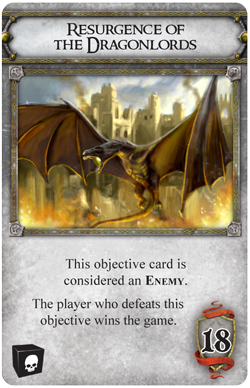 We even caught of glimpse of the first
scenario, in which players race to amass a force large enough to destroy the
mighty Dragonlords. But once your army is built, how do you launch your attack?
Today, we’ll see a brief summary of combat, and we’ll continue our tour of
Rune Age’s scenarios with its most cutthroat game mode: the highly
competitive Runewars campaign.
We even caught of glimpse of the first
scenario, in which players race to amass a force large enough to destroy the
mighty Dragonlords. But once your army is built, how do you launch your attack?
Today, we’ll see a brief summary of combat, and we’ll continue our tour of
Rune Age’s scenarios with its most cutthroat game mode: the highly
competitive Runewars campaign.A war of attrition
Combat in Rune Age can vary slightly depending on the attacker’s target. If your target is a non-player entity, such as a neutral city or an event-triggered enemy card, your Combat action is referred to as a “Battle.” If, on the other hand, your target is controlled by a player, then your Combat action is a “Siege.”
In a Battle, you must carefully consider how much Strength (the “currency” provided by most units) to commit to your foe. For example, to win the first scenario a player must be the first to best the mighty Dragonlords, a feat that requires 18 total strength. By playing cards (typically units) directly from your hand one by one, you’ll try to reach the necessary number. And since many of your units have text effects that trigger when played into combat, you’ll hopefully execute some devastating combos along the way.
This is rarely a simple matter of adding numbers, however. The black die in the corner of the Dragonlords objective card is called the attrition die, and it injects a degree of unpredictability into your Battles. If the card you are targeting calls for it, you must roll this dangerous die just before tallying strength. Then you are forced to destroy a number of your own units equal to the skull icons you roll! Will your forces withstand this counterattack, or will it cause your strength to falter? The wise general would do well to bring some extra muscle, just in case.
A desperate tug-of-war
A Siege, on the other hand, is a fast and furious showdown between two players, and it starts when an attacker targets a city or home realm belonging to another player. Beginning with the attacker, each combatant plays one card at a time from his hand, executing the text effects of his troops when they are triggered. When one player passes (because he is unable or unwilling to play more cards from his hand), he is out of that Siege for good (though his final strength can still be enough to win the day). It is only when both players pass that the Siege ends and strength is tallied to determine a winner.
But this seemingly simple process hides subtle layers of bluffing and strategy. For example, during the course of combat, units can be destroyed or wounded. Destroying a unit returns it immediately to its player’s barracks, where its strength will not be added to the final tally. Wounding a unit rotates it 90 degrees, indicating that it will be destroyed only after strength is tallied. This means that players must carefully manage which of their units are wounded or destroyed and when, and the order in which your cards are played is vitally important. The self-mutilating Uthuk Berserkers gain unholy strength when wounded, so bring them into play first, then have your Flesh Rippers unleash their added power!
Control the dragon runes
If you enjoy the tense direct interaction of Sieges, you’ll find plenty of violent player-versus-player conflict in the second scenario, Runewars. Like the board game that shares its name, this campaign pits players against each other as they vie for control of the dragon runes (and in fact, this scenario brilliantly recreates the experience of the Runewars board game in a more compact version!). Specifically designed for players who seek outright confrontation and player elimination, this scenario grants victory to the last man standing, after an all-out brawl to eliminate the other factions and take their dragon runes from them.
Each player begins with a randomly assigned dragon rune, a powerful artifact that confers a special ability to its bearer. Use your power wisely! If you deal the killing blow to an opponent’s home realm, you may claim his dragon rune, replacing your existing power with the new one.

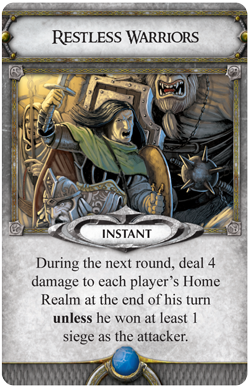

Three of the event cards in the Runewars scenario,
one of which takes effect at the start of every round. Click to enlarge.
From deadly competition to frantic cooperation, Rune Age delivers the game experience you’re looking for. Join us next time for a look at the fully cooperative scenario, and look for Rune Age at your local retailer early in the third quarter of 2011!













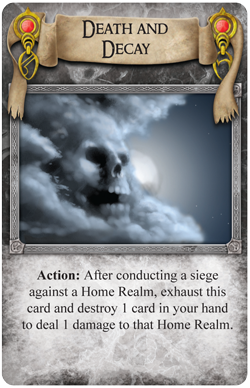
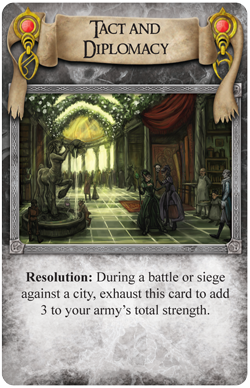
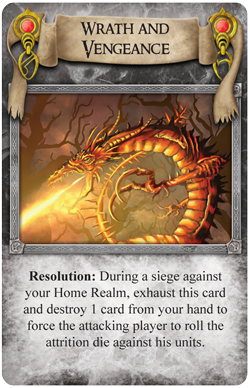





0 comentarios :
Dí lo que piensas...